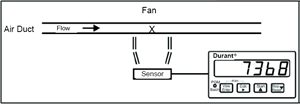Durant Products
|
Flow Rate |
Durant |
|||
|
Eclipse Flow Display for a Fan |
or Pump Application | |||
|
If you hook up the output of a sensor measuring the pressure difference between both sides of a fan to a Durant Eclipse flow totalizer, you can easily and accurately show the air flow (CFM) in the duct work. This principal works for pumps too, and the liquid flow through piping can be displayed.
Unlimited potential for any fan or pump motor controlled by an AC drive found in a variety of industries:
|
A bit more detail: The flow of air or liquid is directly proportional to the square root of the pressure drop on both sides of a fan or pump. By using this physics, flow can be accurately calculated by measuring a pressure difference. A differential pressure sensor is used to measure this pressure drop. Typically, tubes connected to the piping or duct work from both sides of the fan or pump are connected to the sensor. The electrical signal from that sensor would be connected to a display. This signal can be an analog 4-20 mA, or 1-5 VDC, or 0-10 VDC. Now all we need is a meter that can display a scaled square root of the input voltage or current, and then we can show the flow going through the pipe or duct work. Our solution: The Durant Eclipse flow totalizer was designed to address this application. This display can be set up, (scaled), to show flow in cubic feet per minute (CFM), gallons per second, liters per hour, or whatever units established. The same display can also be used to show total gallons, in case, for instance, the customer wants to show total gallons pumped in a day. These two functions, 'flow rate' and 'flow total', are both contained in a single Eclipse. The meter has some options. The most common being alarms for flow or volume. The unit can transmit an analog signal, typically to a chart recorder, so that the information is not just displayed at the instant it occurs, then lost. It can also transmit flow and total information serially, via RS485. What we have here is a killer application. HVAC OEM's often want to display how much air their fans are pushing around. The Eclipse is a very competitive way of doing this. These HVAC applications are well-suited for AC Drives. Very few drives have an analog input card that will take the square root extraction of the signal, so they cannot use a differential pressure sensor's output as feedback for closed loop fan control. (If they do have such a capability, the option is generally much more costly than the price of the Eclipse). The Eclipse can linearize and retransmit the signal to the drive, so that closed loop control may be accomplished. Another thing� Because the Eclipse has scalable analog retransmission capabilities, it makes for a nice signal conditioner that has a display tossed in for free. In flow applications, often the flow sensor's output is a pulse, and a signal conditioner is used to change the pulse train into a 4-20 mA signal, which is more immune to being affected by electrical noise.
|
|||
|
(Flow Batching- One Valve or Two) |
|
| (Flow Batching PLC On Board) | |
| (Flow Rate) | |
|
(Flow Transmitter) |
